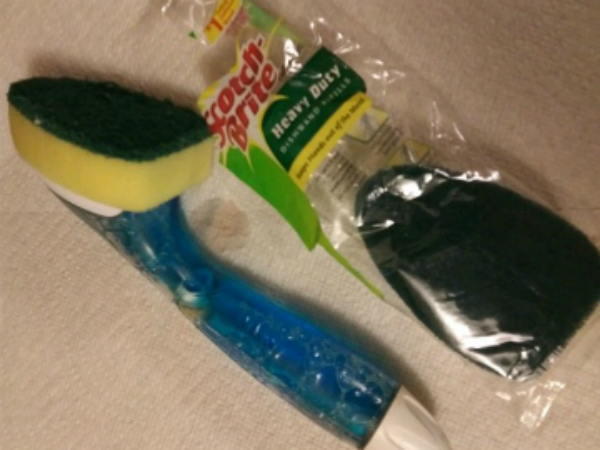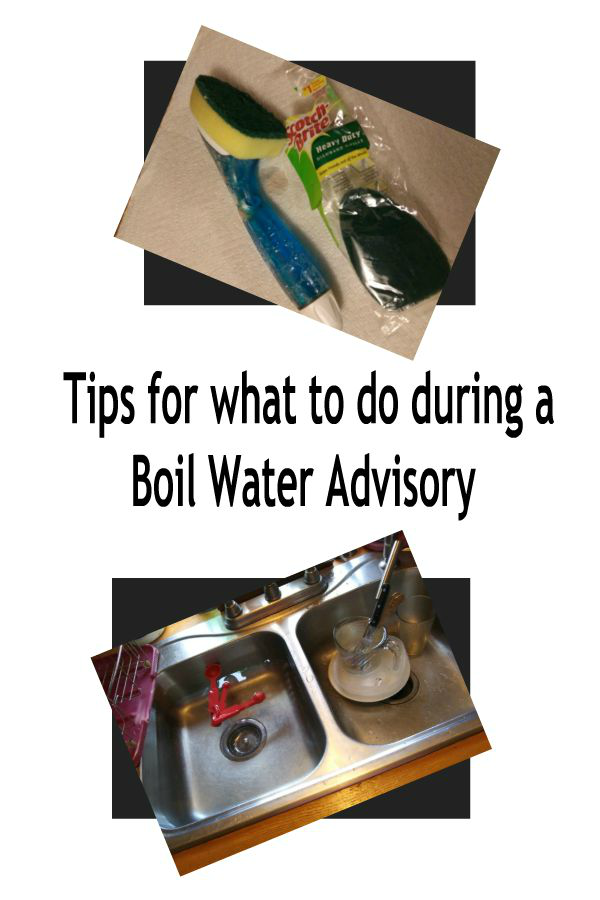We recently had a Boil Water Advisory issued for our area. With all of the rain and bank erosion, we’ve had a couple of water main breaks in our small community. It occurred to me that I really didn’t know what all water advisories actually entailed, so off to do some online research.
Water companies are required to report water main breaks to authorities higher up, and as a precaution they are also required to issue a Boil Water Advisory in the event water was contaminated by E. coli bacteria. After research on the CDC website and a phone call to the local water department, I did find out that there are valves all along the main lines and if there is a leak and risk of contamination, the valves are closed to seal off that section of broken pipe. After the repairs are made, the lines are flushed and then the State sends out an inspector to take water samples in several areas. Those samples are then incubated for 18 -24 hours to make sure the water is bacteria-free.
Save on Pinterest to read later!

We were under a boil water advisory as a precautionary measure because of the potential that water may have been contaminated. A boil water order is issued when contamination is confirmed in the water system. In which case, it is essential that customers boil all water used in the preparation of food and beverage for consumption for a full minute.
Fortunately, in our case, it wasn’t a long ordeal. The call for the advisory came in at 7 pm on Friday evening and the call that it was over was at 8 am Monday morning. We also just happened to have everything we needed.
Meanwhile, back at the house…..
I had figured we would go through about 3 gallons of water daily for drinking purposes between us and the little nursing momma dog that had adopted us three weeks before (prior to having a litter of puppies). I dug out a couple of huge pots and started boiling water.
But there were so many things that I didn’t think of. It didn’t take long to get a system in place to ensure we didn’t risk consuming any nasty bacteria. Most people would probably be alright if they consumed a little bacteria, but babies, elderly people and those with serious health conditions may not. So why take a chance.

We are a participant in the Amazon Services LLC Associates Program, an affiliate advertising program designed to provide a means for sites to earn advertising fees by advertising and linking to Amazon.com and affiliated sites.
Safety Tips for Boil Water Advisory
In the Kitchen
- Drinking Water & Water Filters: Household water filters are not made to remove bacteria or viruses. We have used our Zero Water Filter for years for all drinking purposes and ice, so we continued to do so, making sure the water was fully cooled before filtering. Boiled water may taste a little flat. Shaking the water vigorously or adding a tiny bit of salt may help – a pinch per quart of water and shake well.
- Boiling Water: Bring water to a full rolling boil for a one full minute. Let cool, then pour into clean containers. Water intended for making ice, coffee or tea then went through our water filter and then into the clean containers (pitchers, soda bottles, milk jugs, etc) I also filled a couple of half gallon plastic juice bottles with unfiltered cooled boiled water. One to keep by the kitchen sink for rinsing fresh vegetables and one on the porch to fill the dog’s water bowl.
- Washing Dishes: I filled one sink with water, then added 1 teaspoons of unscented household bleach per gallon of water. (I left the rinse water in the sink all day, because I wash up dishes immediately after using) After washing and rinsing dishes in the other sink with tap water, I put all the dishes, silverware, pans, etc in the bleach water for at least one minute to be sanitized, then into the dish drainer to air dry. Using a dishwasher is considered safe as long as the last rinse cycle reaches 150°.
- Cooking: ANYTHING that comes in contact with food, drinks, ice needs to be sanitized. This includes dishes, glasses, silverware, pans, counter tops, etc. Use cooled boiled water for cooking if needed.

NOTE: If boiling water for consumption is not possible, use regular unscented bleach to make water safe. Add 1/8 teaspoon (or 8 drops) of unscented household liquid bleach to 1 gallon(16 cups) of water. Mix well and wait 30 minutes or more before drinking. Store disinfected water in clean container with a cover.
How to Sanitize Water Containers
Using unscented liquid bleach, make a sanitizing solution with 1 teaspoon bleach to 1 quart of water. Pour bleach/water solution into a clean container and shake well. Make sure the entire inside of the container gets wet with the bleach/water solution. Let the container sit for one minute, and then pour the solution out of the container. Turn the container upside down to air dry.
In the Bathroom
- Teeth Brushing: I kept another 1/2 gallon juice bottle with cooled boiled water on the bathroom counter to rinse the toothbrushes and mouth rinsing after brushing.
- Hand-washing: I suggest keeping a package of antibacterial wipes or a bottle of alcohol-based hand sanitizer on the counter. While researching, I found on one website, that tap water was safe for hand washing, while another said use bottle or cooled boiled water to rinse hands after washing with tap water. In my humble opinion, I would not want to take a chance for young children, the elderly or those with health problems.
- Bathing & Showering: No problem is indicated for bathing or showering, except avoid getting water in your mouth. A sponge bath is recommended for babies and the very young.
Miscellaneous Water Use
- Laundry: It is safe to do laundry with tap water.
- Garden: It is safe to water plants with tap water. However, any part of a plant that may be harvested for consumption needs to be rinsed with cooled boiled water before eating.
- Pets: Avoid filling water bowls with un-treated tap water. Boil and cool the water first.
Water Advisories & Babies
- If breastfeeding, continue to do so.
- Use ready-to-use baby formula.
- Use bottled water to prepare powdered or concentrated baby formula.
- If bottled water is not available, use boiled water.
- If boiling water isn’t possible, disinfect water for baby formula using directions above.
- Wash and sterilize bottles and nipples before use.
- If sterilizing bottles is not possible, use single-serve, ready-to-feed bottles.
Grab a free printable copy of this post here!
I hope these tips help alleviate any concerns about what to do during a Boil Water Advisory. Surprisingly, it really wasn’t that much of an inconvenience. My best advice would be to keep a package of antibacterial wipes and a small bottle of unscented liquid bleach stashed away in case they would ever be needed.
Pin this for future reference!

Thanks for stopping by! Do you have any additional tips to share?
Robin
Oh my lord what a pain in the arse. Thank you for making such a comprehensive list, I’m definitely saving it!
LikeLiked by 1 person
Thanks! I appreciate that. 🙂
LikeLiked by 1 person
Who knew? I have a well and have never really thought too much about it. Perhaps I should! Thank you!
LikeLiked by 1 person
We’ve had a tremendous amount of rain this year and there has been several water main breaks in the county. Luckily this was the first one to affect us.
I don’t hear much about well water being contaminated. But it’s always good to be prepared.
LikeLiked by 1 person
I do have 20 gallons or so of water in the basement, stored in case I lose electricity (in which case the well doesn’t work). So at least I have back-up water!
LikeLiked by 1 person
Yes you do! We don’t have any place to store water. There are a couple of springs nearby that we could have taken a bunch of milk jugs and filled them, but it was rainy and muddy, so decided to just boil water.
LikeLike
Yuck, what a major disruption. Thanks for compiling this practical advice. I have maybe 2.5 gallons of water on hand at any given time. Not enough.
LikeLiked by 1 person
Thanks for reading it. I wasn’t sure how it would go over. 🙂
LikeLike
It’s definitely timely for this region, unfortunately.
You’ve also preserved the information for when it might be needed in the future.
LikeLiked by 1 person
I believe you are in Mississippi or Tennessee? What a pain.
LikeLike
I’m in Kentucky. It’s not near as bad as South of us.
LikeLiked by 1 person
Great points – having a well is a great idea
LikeLiked by 1 person
Great information! I live out in the boonies and we are on a private well. After months and months of testing, treating, testing over and over again, we eventually had to start boiling our water for cooking and buying bottled water for drinking. Our well is contaminated with e-coli and we just couldn’t get rid of it. 😦
LikeLiked by 1 person
That’s really a shame.
LikeLike
Yes. It’s a pain in the butt!
LikeLiked by 1 person
What a GREAT post! You have such wonderful advice!
LikeLike